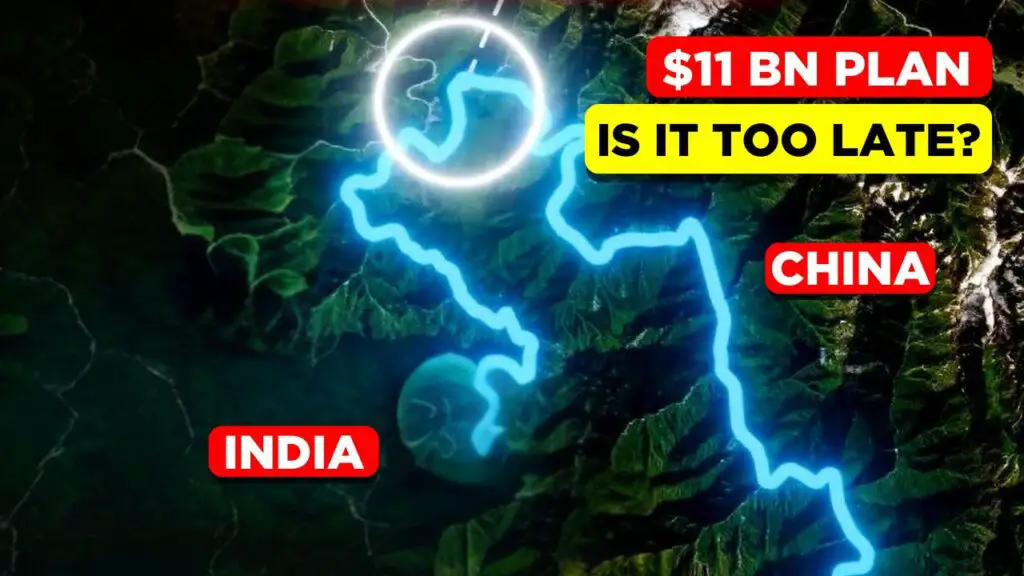In a bold move to safeguard its water security and regional stability, India has announced an $11 billion initiative to counter China’s ambitious super dam project on the Yarlung Tsangpo River, known as the Brahmaputra in India. This strategic response highlights India’s commitment to addressing the geopolitical, environmental, and economic challenges posed by its northern neighbor’s massive hydropower venture.

The Threat of China’s Super Dam
China’s proposed megadam in Medog County, Tibet, is a hydropower behemoth designed to generate an estimated 60 gigawatts of electricity, dwarfing the capacity of the iconic Three Gorges Dam. While the project promises significant energy output for China, it has raised alarm bells in India and downstream countries like Bangladesh.
The Brahmaputra is a lifeline for millions in northeastern India, fueling agriculture, drinking water, and hydropower. Any significant alteration in its flow could disrupt livelihoods, escalate flooding, and damage ecosystems. This makes China’s control over the river a potential flashpoint in South Asia.
India’s $11 Billion Countermeasure
India’s response is a multipurpose hydropower project in Arunachal Pradesh. This massive infrastructure plan aims to ensure water security, flood control, and regional economic development. The project focuses on four key areas:
1. Hydropower Generation
The Brahmaputra River offers enormous hydropower potential. India plans to construct a series of dams to generate electricity, boosting the region’s energy resources and reducing dependence on fossil fuels.
2. Water Flow Regulation
China’s upstream activities, including the ability to store or release water, could potentially disrupt the natural flow of the Brahmaputra. India’s project aims to counter this by managing downstream water flow effectively, ensuring consistent availability for agriculture, drinking, and industrial purposes.
3. Flood Mitigation
Flooding is a perennial issue in Assam and Arunachal Pradesh, with the Brahmaputra swelling during the monsoon season. The new dams will play a vital role in controlling floodwaters, protecting millions of lives and properties from devastation.
4. Regional Development
The project is expected to be a boon for northeastern India, creating employment opportunities, improving infrastructure, and stimulating local economies. This development will also address longstanding issues of underdevelopment in the region.
Geopolitical Implications
India’s $11 billion initiative is as much a strategic move as it is an infrastructure project. By countering China’s upstream dam, India signals its readiness to protect its territorial and water sovereignty.
Like Us on Facebook!
This development is also likely to impact regional diplomacy. As water-sharing disputes grow in prominence, India’s proactive measures could strengthen its position in negotiations with both China and Bangladesh.
Subscribe Us on YouTube!
Challenges to Overcome
1. Displacement of Communities
Large infrastructure projects often require the relocation of local communities. Ensuring fair compensation, rehabilitation, and community support will be critical to avoiding unrest.
2. Ecological Impact
The Brahmaputra basin is a biodiversity hotspot. Large dams could disrupt aquatic ecosystems and wildlife habitats. Balancing development with environmental sustainability is a significant challenge.
3. Seismic Risks
The Himalayan region is geologically unstable and prone to earthquakes. Constructing dams in such a region requires state-of-the-art technology and strict safety protocols to avoid catastrophic failures.
The Strategic Importance of the Brahmaputra
The Brahmaputra River is not just a water resource; it is a strategic asset in South Asia’s geopolitical landscape. By launching this $11 billion project, India underscores the importance of securing its water resources, especially amid rising tensions with China.
The initiative is not merely about building dams; it is a statement of resilience, self-reliance, and preparedness. It also serves as a deterrent to potential unilateral actions by China that could threaten regional stability.
Conclusion
India’s $11 billion hydropower plan in Arunachal Pradesh is a critical step in safeguarding its water security and countering China’s super dam on the Brahmaputra. The project reflects India’s strategic vision for balancing economic growth, ecological preservation, and regional stability.
While challenges like ecological impact and community displacement remain, the initiative’s success could set a precedent for managing transboundary water disputes. As water resources become increasingly contested in the 21st century, India’s decisive approach could shape the future of South Asia’s shared rivers.



















